Red and black bugs are some of the most visually striking insects found in nature. These bugs often display bold colors that not only make them stand out but also serve as warning signals to predators.
From beetles to wasps, there are countless species that boast this vivid color combination. Identifying red and black bugs can be essential for understanding their role in the ecosystem, whether they are beneficial predators or potential pests.
In this article, we’ll explore 54 fascinating red and black bug species, complete with identification tips and pictures to help you recognize them.
Different Types of Red and Black Bugs
Eastern Boxelder Bug

The Eastern Boxelder Bug (Boisea trivittata) has a black body with red markings along the edges. This species feeds on the leaves, seeds, and fruits of boxelder and ash trees. Although not harmful to crops or trees, they can become a nuisance when they invade homes during colder months.
Their populations are often left unchecked, as they have few natural predators due to their unpleasant taste.
Western Boxelder Bug

The Western Boxelder Bug (Boisea rubrolineata) is primarily black and gray with red stripes running along its elongated body. Native to the western U.S., this bug relies on boxelder trees, where both nymphs and adults feed on the seeds.
During colder months, adults often seek shelter indoors, where they survive in a hibernation-like state. Their black and red-striped appearance is distinct, and their resilience allows them to overwinter in barns, homes, or garages.
Red-shouldered Bug

The Red-shouldered Bug (Jadera haematoloma) is predominantly black, with two short red stripes near the base of its wings. Native to the Americas, this bug is now also found in Asia. Known for feeding on balloon vine seeds, it uses its piercing mouthparts to access the seeds.
The Red-shouldered Bug grows up to 13.5mm, making it larger than most ladybugs. Its black body often causes confusion with similar-looking species like the Boxelder Bug.
Milkweed Assassin Bug
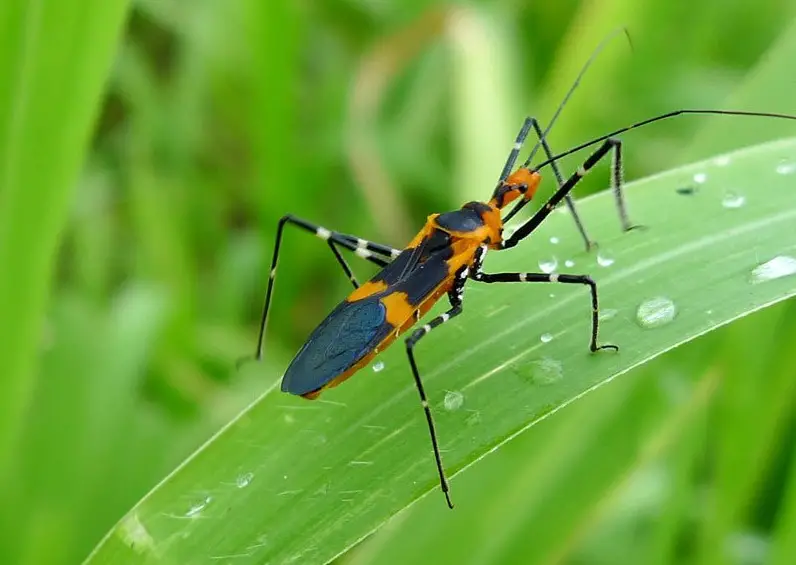
The Milkweed Assassin Bug (Zelus longipes) is a red and black predator found across North and South America. It’s an important biocontrol agent in agricultural fields, particularly corn crops, where it preys on caterpillars and adult moths.
This bug has long legs and an elongated body, allowing it to efficiently hunt down caterpillars, which are its preferred prey due to their inability to fly. Southeastern U.S. corn fields often host large populations of this beneficial insect.
False Milkweed Bug

The False Milkweed Bug (Lygaeus turcicus) is often mistaken for other milkweed bugs due to its black body and red or yellow stripes. However, it feeds on the seeds of false sunflower rather than milkweed. Found in the Eastern U.S., this bug’s distinct red or yellow stripes cover both its wings and head.
While the name may cause confusion, the False Milkweed Bug is closely associated with flowers from the aster family, not milkweed.
Twice-stabbed Stink Bug

The Twice-stabbed Stink Bug (Cosmopepla lintneriana) is a shiny black bug with two red dots on its back and a red stripe behind its head. Growing up to 6.5mm, it’s smaller than most stink bugs. This bug is primarily found on milk thistle but can also damage crops like oats and mint.
Despite its small size, it plays a significant role in certain ecosystems by feeding on both plants and insects.
White-crossed Seed Bug

The White-crossed Seed Bug (Neacoryphus bicrucis) is a black and red bug identified by the white, X-shaped mark on its back. Native to North and South America, it is often seen in open fields, feeding on sunflower-daisy flowers.
The bug’s elongated oval body makes it easily recognizable, and it thrives in diverse habitats, including various elevations and regions across the U.S., as well as Asia and Oceania.
Mediterranean Red Bug

The Mediterranean Red Bug (Scantius aegyptius) is a migrating species in the U.S., primarily found in Southern California. These bugs, with their black and red bodies, feed on knotweed and travel in large groups when their food supply runs low.
Although they can be seen in vast numbers, Mediterranean Red Bugs don’t harm crops, focusing instead on weeds like knotweed. They migrate collectively, creating a striking spectacle.
Florida Predatory Stink Bug

The Florida Predatory Stink Bug (Euthyrhynchus floridanus) is a multicolored bug with a black base, orange spots, and green patches. This species, found primarily in Florida, is highly beneficial as it feeds on various crop pests, including caterpillars and grasshoppers.
While typically carnivorous, the Florida Predatory Stink Bug can adapt to feed on non-pest insects when necessary, making it an important natural pest control agent in agriculture.
Eastern Bloodsucking Conenose

The Eastern Bloodsucking Conenose (Triatoma sanguisuga) is a large, 21mm bug that bites humans, particularly around the mouth, earning it the nickname “kissing bug.” Known to suck blood, it can spread Chagas disease, although the risk is minimal in the U.S.
This black and orange bug primarily feeds at night, and while its bite is painless, the potential for disease transmission has made it a concern in some regions.
Charcoal Seed Bug

The Charcoal Seed Bug (Melacoryphus lateralis) is a black and red species with distinct red stripes along its sides and behind its head. Found in the Western U.S., particularly in dry and desert regions, it sometimes displays gray coloring on its wings.
These bugs feed on seeds and are commonly seen in scrubland habitats. Their unique coloring and habitat preferences distinguish them from other seed bugs.
European Firebug

The European Firebug (Pyrrhocoris apterus) is found in Europe, North America, and Asia. These black and red bugs often thrive on various tree species and are frequently mistaken for squash bugs due to their similar appearance.
The body of the European Firebug is black with red vertical, diagonal, and horizontal stripes. Nymphs are especially easy to spot as they tend to congregate, living in colonies as a defensive strategy, making them less likely to be preyed upon.
California Lady Beetle

The California Lady Beetle (Coccinella californica) is native to California, particularly in its coastal regions. This lady beetle features a red elytra, sometimes with a rusty hue, and two small white spots near the base of its wings.
Its thorax is black with additional small white dots, which makes the beetle mostly appear black and red. Known for being a predator of aphids, this species plays an important role in pest control.
Shiny Flea Beetle

The Shiny Flea Beetle (Asphaera lustrans) is primarily found in southern U.S. states like Arizona and Florida. Its red head and thorax contrast with its black elytra. This beetle is particularly drawn to mint plants, especially wild mint such as skullcap.
It can often be seen year-round in its native habitat and is recognized by its red color pattern, which is inverse to that of the California Lady Beetle.
Master Blister Beetle

The Master Blister Beetle (Lytta magister) is known for its red upper body and black wings. Found in desert areas like the Mojave Desert, its larvae feed on bee nests, particularly on bee provisions. Adult beetles, however, switch to feeding on flowers, such as brittlebush.
The Master Blister Beetle plays a role in ecosystems by feeding on insects during its larval stage, though it can also harm bee populations.
Asian Lady Beetle

The Asian Lady Beetle (Harmonia axyridis) is recognized by its domed, oval body, ranging between 5.5 to 8.5mm. It often displays black elytra with up to 22 black spots. Originally introduced in the U.S. in 1916 to control aphid populations, it has since spread across the country.
Though beneficial in pest control, it can become a household nuisance, especially in colder months when they seek shelter indoors.
Seven-spotted Lady Beetle
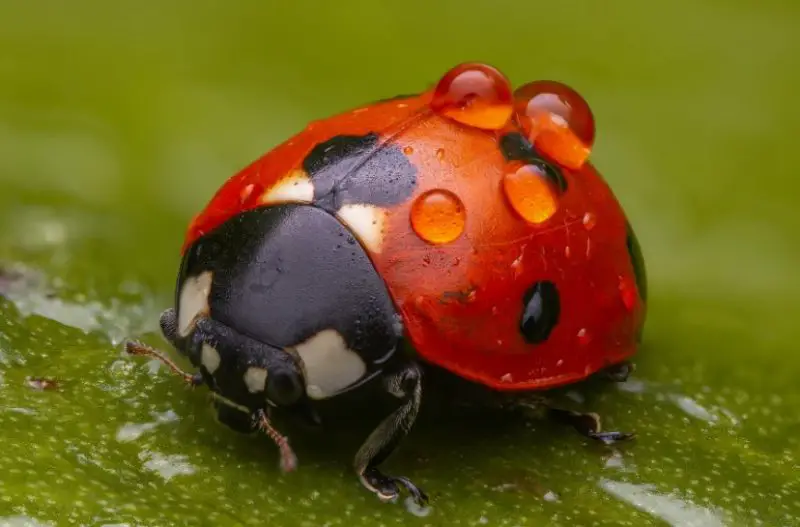
The Seven-spotted Lady Beetle (Coccinella septempunctata) is larger than its Asian counterpart, reaching up to 12.5mm. Its red elytra is marked with seven distinctive black spots. A natural predator, it helps control aphid populations.
This species protects itself from predators by secreting a foul-tasting liquid and may play dead to avoid danger. Originally native to Europe, it is now widespread across North America.
Spotted Lanternfly

The Spotted Lanternfly (Lycorma delicatula) is a notorious pest, identified by its spotted wings. As it matures, its hind wings turn red, while the upper wings remain covered in black spots. Accidentally introduced from China, this species has become a major agricultural pest in the U.S., particularly in Pennsylvania.
Due to its devastating impact on crops, strict quarantines have been enforced to control its spread.
Large Milkweed Bug

The Large Milkweed Bug (Oncopeltus fasciatus) is a black and red species, growing up to 12mm. Found in North and Central America, it feeds primarily on milkweed plants. Northern populations migrate south, whereas southern ones remain in place.
Despite their striking appearance, these bugs are not pests, as they only consume milkweed sap, playing a role in maintaining the plant’s ecological balance.
Convergent Lady Beetle

Convergent Lady Beetles (Hippodamia convergens) are small predatory beetles with red elytra and black spots, known for their role in aphid control. They have a black head with white markings.
Common across the U.S., these beetles spend much of their year in dormancy, emerging in the spring to hunt in large groups. Their role in agriculture is significant, helping to reduce the need for chemical pesticides.
Red Milkweed Beetle

The Red Milkweed Beetle (Tetraopes tetrophthalmus) is distinguished by its bright red and black body. As a herbivore, it feeds on milkweed plants and drinks sap by opening plant veins. These beetles are also toxic to predators due to the toxins absorbed from milkweed.
Unlike other similar species, Red Milkweed Beetles produce specific sounds to communicate, which makes them easier to identify.
Swift Feather-legged Fly

The Swift Feather-legged Fly (Trichopoda pennipes) can have red or black and orange coloration. Native to the U.S., it feeds on plants, while its larvae act as parasitoids, feeding on bugs like squash bugs. Adults typically consume nectar and are often found near their larvae’s host plants.
They lay their eggs on other insects, especially squash and stink bugs, making them a natural biological control agent.
Shiny Acrobat Ant

The Shiny Acrobat Ant (Crematogaster laeviuscula) is known for its unique ability to eat wasps. These ants are often found both indoors and outdoors, building nests in dark areas, including inside walls or near homes. They also make their nests in trees and can grow into large colonies.
This species is common across various countries, and its diet includes both insects and plant matter, making it an adaptable and resourceful insect.
Twice-Stabbed Lady Beetle

The Twice-Stabbed Lady Beetle (Chilocorus stigma) is distinguished by its black body with two red dots, which resemble stab marks. These small but predatory beetles are found in regions such as Florida, where they feed on aphids, mealybugs, and other invasive insects.
Their role as natural predators makes them valuable in pest control, often reducing the need for pesticides. These beetles also overwinter in the ground, often returning to the same area the following year.
Two-lined Leatherwing
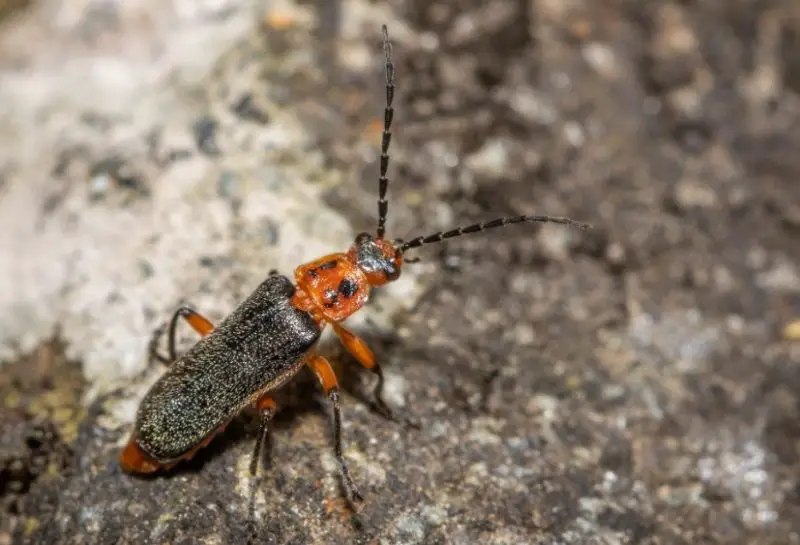
The Two-lined Leatherwing (Atalantycha bilineata) is another woodland species that plays an important role in pollination. With gray to brown wings and a brownish-red underside, this insect helps spread pollen as it feeds on other insects that consume pollen.
Its name is derived from its soft, leather-like wings. Though beneficial, these bugs are more interested in preying on insects than the pollen itself.
Pigeon Horntail

The Pigeon Horntail (Tremex columba) is a large insect that can reach up to 2 inches in length, with red-brown, black, and yellow coloring. This species lays its eggs in wood, particularly softwood, where the larvae and pupae continue to feed on the wood.
Pigeon Horntails are often found in indoor settings, as well as outdoors, and are especially prevalent around decaying wood.
End Band Net-winged Beetle

The End Band Net-winged Beetle (Calopteron terminale) is known for its deep wing grooves and long, thick black antennae. Found in the Northeastern U.S., this red and black or red and orange beetle lays its eggs in dead trees or under tree bark.
Like the Pigeon Horntail, it feeds on insects attracted to decaying trees, helping to break down dead wood in forest ecosystems.
Pale-bordered Field Cockroach
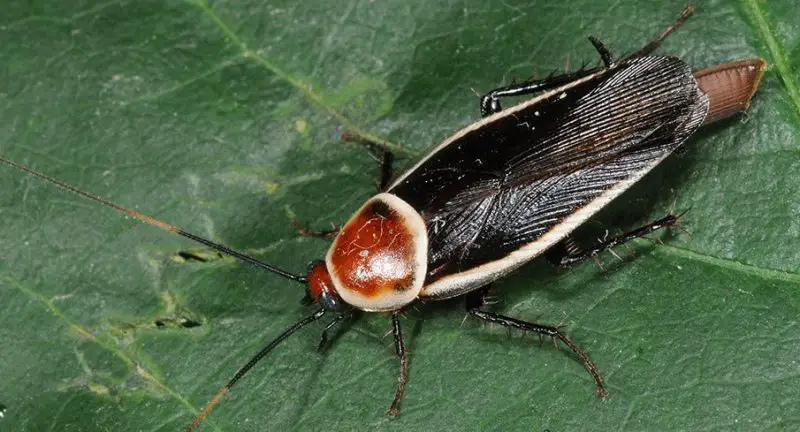
The Pale-bordered Field Cockroach (Pseudomops septentrionalis) is an outdoor species that feeds on various types of plants. These cockroaches have elongated bodies, around 0.5 inches in length.
Their wings are black, with a brown head and off-white margins. The legs and antennae are completely black. Unlike other roach species, these bugs do not infest homes but instead live and feed outdoors.
Pleasing Fungus Beetle

The Pleasing Fungus Beetle (Megalodacne heros) is commonly found on trees such as maple, redbud, and water oak. These beetles feed on fungi growing on these trees and lay their eggs in areas where fungus thrives.
Pleasing Fungus Beetles are nocturnal and tend to hide under tree bark, making them difficult to spot. While they feed on fungi, they only affect trees that are already in poor health.
Small Milkweed Bug

The Small Milkweed Bug (Lygaeus kalmii) is initially all red but develops a red and black or orange and black pattern as it matures. While they mainly feed on milkweed, they can turn carnivorous in the absence of their preferred plant.
Non-migratory, these bugs are common throughout North America, mating year-round. Their adaptable diet and ability to live in diverse environments make them a widespread species.
Common Eastern Firefly

The Common Eastern Firefly (Photinus pyralis) is known for its glowing abdomen, which emits light at night. Its black body is highlighted by orange-red markings on the head and wings. Only males can fly, and they use their glow to attract mates.
This species is often seen flying in groups at night, creating an enchanting spectacle in many parts of eastern North America.
Spotted Pink Ladybeetle

The Spotted Pink Ladybeetle (Coleomegilla maculata) is recognized by its pink, red, or yellow body with six black spots on each wing. Unlike other ladybeetles, this species prefers crops like soybean and alfalfa where aphids thrive.
Known for their beneficial role in controlling aphid populations, these beetles are often left untreated by farmers, allowing them to naturally manage crop pests.
Cocklebur Weevil

The Cocklebur Weevil (Rhodobaenus quinquepunctatus) has a red body with black dots and feeds primarily on cocklebur stems, ragweed, and roots. This small weevil uses its elongated snout to bore into plant stems or roots, often stunting the growth of sunflower-related plants.
It is rarely larger than 0.5 inches and can damage a wide variety of plants through its feeding habits.
Eurasian Red-and-black Melyrid

The Eurasian Red-and-black Melyrid (Anthocomus equestris) is a beneficial bug often found indoors or near crops. This species feeds on pests and is most common in Virginia, although it has spread across various states. Its body is black with red markings, including spiny antennae. The bug’s colors can range from pure red and black to rust-red and black, depending on the region.
Red-banded Fungus Beetle

The Red-banded Fungus Beetle (Megalodacne fasciata) is native to North America and easily identified by its shiny black body with red bands. It feeds on both plant leaves and fungus-affected vegetation, though its impact on crops is minimal.
The bug’s black head and red-banded body make it a visually striking species. While not a harmful pest, it can occasionally be found indoors.
Two-lined Spittlebug

The Two-lined Spittlebug (Prosapia bicincta) is native to the U.S. and parts of Central America. With a black body and either red or orange bands on its wings, this bug feeds on different plants at various stages of its life cycle.
Nymphs prefer grasses and can invade lawns, while adults feed on small trees such as holly and eastern redbud. The Two-lined Spittlebug has a distinctive feeding pattern depending on its developmental stage.
Spotless Lady Beetle
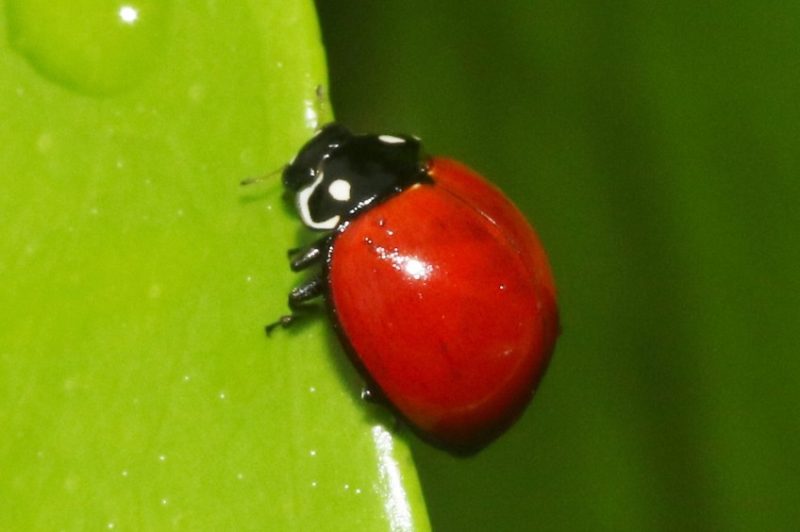
The Spotless Lady Beetle (Cycloneda sanguinea) is a red-brown ladybug found in southern U.S. regions and across Central and South America. Its smooth, red dome-shaped elytra and black-and-white head make it easily recognizable.
Predatory in nature, it feeds on aphids and is known for its role in controlling aphid populations on plants like milkweed. Both adult and larval stages are effective predators, making it a valuable species in natural pest control.
Harlequin Bug
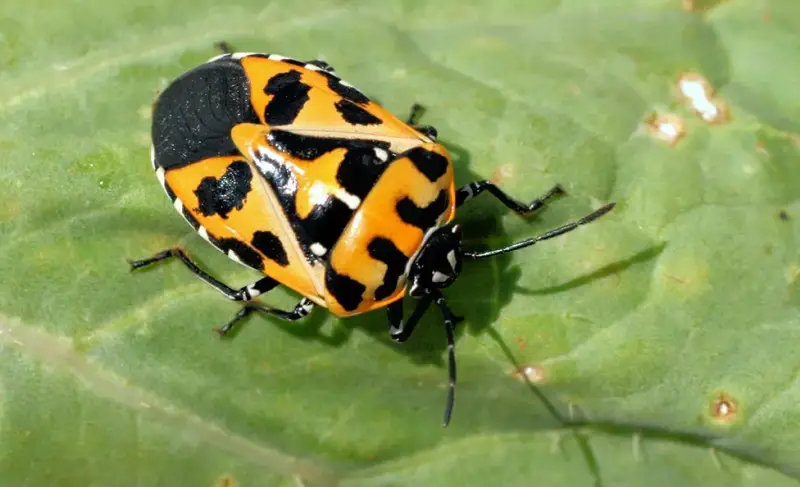
The Harlequin Bug (Murgantia histrionica) is a known pest of cabbages and other related plants. Its black body with red stripes and black spots gives it a poisonous appearance, which helps deter predators. Found in warm areas of North America, this species has a unique mating strategy involving high male competition.
Males often migrate to new areas to find females with fewer competing males. The Harlequin Bug is particularly problematic for crops in the cabbage family.
Common Lovebug

The Common Lovebug (Plecia nearctica) is a well-known black and red bug found throughout North America. It is most famous for being a nuisance to drivers, as it tends to be attracted to vehicle lights during its two mating flights (three in Florida).
What sets this species apart is its mating behavior, where male and female Lovebugs remain attached for up to several days, even while flying. These bugs are not harmful and can be considered mildly beneficial due to their larvae’s role in breaking down decaying plant matter.
Reticulated Net-winged Beetle

The Reticulated Net-winged Beetle (Calopteron reticulatum) is recognized by its orange or red bands on ridged wings. This beetle is primarily active during early mornings and evenings, where it feeds on decaying plant matter. Found near forests and open woodland areas, it thrives on moist dead plants.
The beetle’s females lay their eggs on decaying trees, continuing their lifecycle in areas rich in decomposing organic material.
Squash Vine Borer Moth

The Squash Vine Borer Moth (Melittia cucurbitae) is often mistaken for a bee or wasp due to its black and red coloring. It is a known pest for crops like zucchini and squash. The larvae of this species bore into plant stems, causing significant damage that can kill the plant.
Effective pest control measures, such as applying pesticides, are typically required to protect crops from this moth during its active season.
Cinnabar Moth

The Cinnabar Moth (Tyria jacobaeae) is notable for its striking black and red body, with alternating triangular shapes on its wings. While the adults feed on pollen, the larvae are known to feed on plants like ragwort and may even resort to cannibalism.
This behavior results in a high mortality rate among larvae. Those that survive grow into adults that continue feeding on plants for nectar.
Dark Paper Wasp

The Dark Paper Wasp (Polistes fuscatus) has a striking mix of red-brown, black, and yellow colors. This social wasp is found throughout North America in wooded areas, where it uses wood to construct its nests.
These colonies are led by a dominant queen, but other female wasps, known as foundresses, work together with the queen to maintain the nest. The Dark Paper Wasp plays a key role in ecosystems by feeding on pests and plant matter.
Great Golden Digger Wasp

The Great Golden Digger Wasp (Sphex ichneumoneus) is one of the most common red and black wasps in the U.S. While its body is mostly red and black, it may also display yellow, white, or off-white coloring. This species is known for digging underground nests where females lay their eggs.
The larvae feed on paralyzed insects, typically placed in the nests by adult females. Clusters of these nests are often found in sandy or loose soil environments.
Common Eastern Velvet Ant

The Common Eastern Velvet Ant (Dasymutilla occidentalis) is a strikingly red and black furry insect, commonly found in southern parts of North America. Known for its painful sting, this ant-like wasp has earned the nickname “cow killer” due to myths about its sting’s potency.
The velvet ant is parasitic, laying its eggs in wasp nests and killing the host egg to ensure its larvae’s survival.
Pacific Velvet Ant

The Pacific Velvet Ant (Dasymutilla aureola) is another parasitic species resembling ants. It cannot fly and moves only on the ground. Found in coastal California, it has a brown or reddish-brown body and black markings.
Known for its painful sting, the Pacific Velvet Ant is commonly seen in arid environments where it feeds on plants. Its resemblance to ants is a form of mimicry, providing it some protection from predators.






